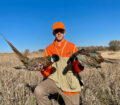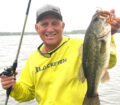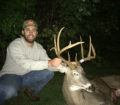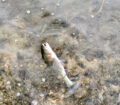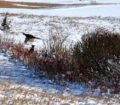By Bob Jensen
Fishing the Midwest Fishing Team
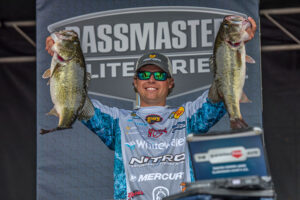
(photo by Bob Jensen) Jay Przekurat with a pair of largemouth bass he took during a tournament. Anglers who can catch pressured fish consistently will consistently catch more fish.
Fishing pressure is something that seems to be more of a factor in more places. Although sometimes we don’t like the additional fishing pressure, it’s not all bad. Fishing is a good thing for almost all of us almost all of the time. Following are some thoughts on fishing pressure and how to deal with it.
Fishing pressure is everywhere, and it can impact how and where we fish and what we catch. It applies to most species of fish, with bass, crappies, walleyes, and muskies being especially affected in many areas. When a body of water gets a lot of fishing pressure, the fish will sometimes be most active for shorter periods of time and at times when the pressure is less. Since most fishing pressure takes place from morning to late afternoon or early evening, the fish will often bite better very early or later on in the day.
Also, many bodies of water have what are called “community holes”. These are locations that have developed a reputation for being good fishing spots. The thing is, they were good fishing spots earlier in the year or earlier in the previous century. Now, they’re not so good due to the fishing pressure that they receive. Nonetheless, they still get hit hard. It’s usually better to avoid the community holes and find the spots that aren’t as well-known.
Jay Przekurat is a bass tournament angler who calls Wisconsin home. He travels to several different states to compete in tournaments every year. He has learned a lot about fishing pressure and how fishing pressure in one part of the country is different than fishing pressure in another part of the country.
In southern states, fishing is very popular, and due to milder weather, those folks can fish year ‘round. Some lakes will see hundreds of boats a day. The fish, mostly largemouth bass and crappies, see baits every day of the year. Anglers take turns on the various spots. It’s not uncommon to pull up on a point that is already being fished and just wait until that angler leaves. You then pull onto the point, take your turn fishing it, then move along and give the next angler a shot at it. That’s fishing pressure!
In Wisconsin, there are lots of smaller lakes. Many of these lakes don’t see much fishing pressure for several months out of the year. Some lakes will have significant ice fishing pressure, but many won’t. In the spring, summer, and fall, fishing pressure will increase. These lakes won’t have hundreds of boats like a lake in more southerly regions, but because the lakes are smaller, they have a limited number of good fishing spots. Fewer anglers but fewer good spots equals fishing pressure.
Pressured fish can be difficult to catch. Jay says that wherever he wets a line, when the fish are pressured, smaller baits are usually the way to go. In many places, he reaches for the rod with a KVD 1.5 Squarebill crankbait attached. This bait has an erratic action and triggers reaction strikes.
His other go-to is a 4 inch Rage Bug. He rigs it either Texas-style or on a rubber-legged jig. He experiments with jig and Rage Bug colors.
Fishing pressure is real and getting more real. However, if you will do different things in different places, the catching will be just as good as usual. Maybe even better.

